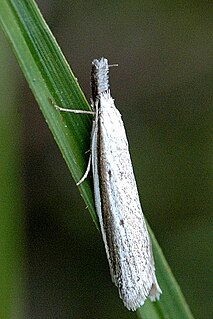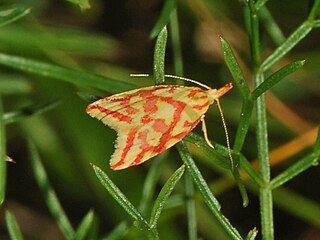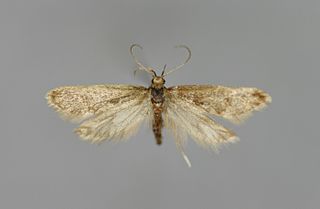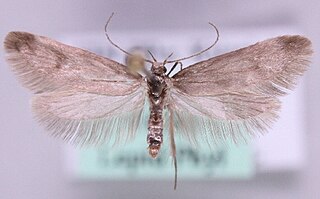| Denisia albimaculea | |
|---|---|
| Scientific classification | |
| Kingdom: | |
| Phylum: | |
| Class: | |
| Order: | |
| Family: | |
| Genus: | |
| Species: | D. albimaculea |
| Binomial name | |
| Denisia albimaculea (Haworth, 1828) | |
Denisia albimaculea is a moth of the Oecophoridae family. It is found in Europe.

Moths comprise a group of insects related to butterflies, belonging to the order Lepidoptera. Most lepidopterans are moths, and there are thought to be approximately 160,000 species of moth, many of which have yet to be described. Most species of moth are nocturnal, but there are also crepuscular and diurnal species.

Oecophoridae is a family of small moths in the superfamily Gelechioidea. The phylogeny and systematics of gelechoid moths are still not fully resolved, and the circumscription of the Oecophoridae is strongly affected by this.
The wingspan is 9–12 mm. The moth flies from May to June depending on the location. [1]

The wingspan of a bird or an airplane is the distance from one wingtip to the other wingtip. For example, the Boeing 777-200 has a wingspan of 60.93 metres, and a wandering albatross caught in 1965 had a wingspan of 3.63 metres, the official record for a living bird. The term wingspan, more technically extent, is also used for other winged animals such as pterosaurs, bats, insects, etc., and other fixed-wing aircraft such as ornithopters. In humans, the term wingspan also refers to the arm span, which is distance between the length from one end of an individual's arms to the other when raised parallel to the ground at shoulder height at a 90º angle. Former professional basketball player Manute Bol stands at 7 ft 7 in (2.31 m) and owns one of the largest wingspans at 8 ft 6 in (2.59 m).
The larvae live under and feed on dead bark, decayed wood and amongst other plant material from conifers such as Larix and deciduous trees such as Ulmus and Aesculus .

The genus Aesculus, with varieties called buckeye and horse chestnut, comprises 13–19 species of flowering plants in the soapberry and lychee family Sapindaceae. They are trees and shrubs native to the temperate Northern Hemisphere, with six species native to North America and seven to thirteen species native to Eurasia. Also, several hybrids occur. Aesculus exhibits a classical Arcto-Tertiary distribution.

















